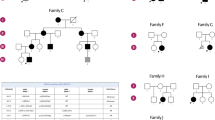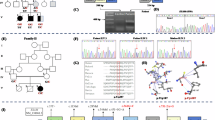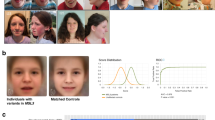Abstract
Myhre syndrome (MS, MIM 139210) is a rare multisystemic disorder caused by recurrent pathogenic missense variants in SMAD4. The clinical features have been mainly documented in childhood and comprise variable neurocognitive development, recognizable craniofacial features, a short stature with a pseudo-muscular build, hearing loss, thickened skin, joint limitations, diverse cardiovascular and airway manifestations, and increased fibrosis often following trauma or surgery. In contrast, adults with MS are underreported obscuring potential clinical variability. Here, we describe 24 adults with MS, including 17 diagnosed after the age of 18 years old, and we review the literature on adults with MS. Overall, our cohort shows a milder phenotype as well as lower mortality rates compared to what has been published in literature. Individuals with a codon 500 variant in SMAD4 present with a more pronounced neurodevelopmental and systemic phenotype. However, in contrast to the literature, we observe cardiovascular abnormalities in individuals with the p.(Arg496Cys) variant. In addition, we describe scoliosis as a new manifestation and we report fertility in two additional males with the p.(Arg496Cys). In conclusion, our study contributes novel insights into the clinical variability of MS and underscores the importance of variant-specific considerations, and we provide recommendations for the management of MS in adulthood.
This is a preview of subscription content, access via your institution
Access options
Subscribe to this journal
Receive 12 print issues and online access
269,00 € per year
only 22,42 € per issue
Buy this article
- Purchase on SpringerLink
- Instant access to full article PDF
Prices may be subject to local taxes which are calculated during checkout



Similar content being viewed by others
Data availability
Code availability
The data generated and/or analyzed during this study can be found within this article and the Supplementary files.
Change history
13 September 2024
There was an error in the labeling of Table 1.
10 September 2024
A Correction to this paper has been published: https://doi.org/10.1038/s41431-024-01690-z
References
Solomon AM, Solomon BD. Age-related survey of clinical genetics literature and related resources. Am J Med Genet C Semin Med Genet. 2023;193:103–8.
Lin AE, Alali A, Starr LJ, Shah N, Beavis A, Pereira EM, et al. Gain-of-function pathogenic variants in SMAD4 are associated with neoplasia in Myhre syndrome. Am J Med Genet A. 2020;182:328–37.
Lindor NM, Kasperbauer JL, Hoffman AD, Parisi JE, Wang H, Warman M. Confirmation of existence of a new syndrome: LAPS syndrome. Am J Med Genet. 2002;109:93–9.
Oldenburg MS, Frisch CD, Lindor NM, Edell ES, Kasperbauer JL, O’Brien EK. Myhre-LAPs syndrome and intubation related airway stenosis: keys to diagnosis and critical therapeutic interventions. Am J Otolaryngol. 2015;36:636–41.
Lindor NM, Gunawardena SR, Thibodeau SN. Mutations of SMAD4 account for both LAPS and Myhre syndromes. Am J Med Genet A. 2012;158a:1520–1.
Lindor NM. LAPS syndrome and Myhre syndrome: two disorders or one? Am J Med Genet A. 2009;149a:798–9.
Myhre SA, Ruvalcaba RH, Graham CB. A new growth deficiency syndrome. Clin Genet. 1981;20:1–5.
Caputo V, Cianetti L, Niceta M, Carta C, Ciolfi A, Bocchinfuso G, et al. A restricted spectrum of mutations in the SMAD4 tumor-suppressor gene underlies Myhre syndrome. Am J Hum Genet. 2012;90:161–9.
Piccolo P, Mithbaokar P, Sabatino V, Tolmie J, Melis D, Schiaffino MC, et al. SMAD4 mutations causing Myhre syndrome result in disorganization of extracellular matrix improved by losartan. Eur J Hum Genet. 2014;22:988–94.
Kandhaya-Pillai R, Hou D, Zhang J, Yang X, Compoginis G, Mori T, et al. SMAD4 mutations and cross-talk between TGF-β/IFNγ signaling accelerate rates of DNA damage and cellular senescence, resulting in a segmental progeroid syndrome-the Myhre syndrome. Geroscience. 2021;43:1481–96.
Priestley JRC, Rippert AL, Condit C, Izumi K, Kallish S, Drivas TG. Unmasking the challenges of Kabuki syndrome in adulthood: a case series. Am J Med Genet C Semin Med Genet. 2023;193:128–38.
Wallin L, Gillberg C, Fernell E, Gillberg C, Billstedt E. Neurodevelopmental and other psychiatric disorders in 22q11.2 deletion syndrome from childhood to adult age: prospective longitudinal study of 100 individuals. Am J Med Genet C Semin Med Genet. 2023;193:172–82.
Meerschaut I, Beyens A, Steyaert W, De Rycke R, Bonte K, De Backer T, et al. Myhre syndrome: a first familial recurrence and broadening of the phenotypic spectrum. Am J Med Genet A. 2019;179:2494–9.
Demir Ş, Alavanda C, Yeşil G, Aslanger AD, Ateş EA. A second family with Myhre syndrome caused by the same recurrent SMAD4 pathogenic variation (p.Arg496Cys). Mol Syndromol. 2023;14:175–80.
Lin AE, Michot C, Cormier-Daire V, L’Ecuyer TJ, Matherne GP, Barnes BH, et al. Gain-of-function mutations in SMAD4 cause a distinctive repertoire of cardiovascular phenotypes in patients with Myhre syndrome. Am J Med Genet A. 2016;170:2617–31.
Yang DD, Rio M, Michot C, Boddaert N, Yacoub W, Garcelon N, et al. Natural history of Myhre syndrome. Orphanet J Rare Dis. 2022;17:304.
Michot C, Le Goff C, Mahaut C, Afenjar A, Brooks AS, Campeau PM, et al. Myhre and LAPS syndromes: clinical and molecular review of 32 patients. Eur J Hum Genet. 2014;22:1272–7.
Cătană A, Simonescu-Colan R, Cuzmici-Barabaș Z, Militaru D, Iordănescu I, Militaru MS. First documented case of Myhre syndrome in Romania: a case report. Exp Ther Med. 2022;23:323.
Cappuccio G, Brunetti-Pierri N, Clift P, Learn C, Dykes JC, Mercer CL, et al. Expanded cardiovascular phenotype of Myhre syndrome includes tetralogy of Fallot suggesting a role for SMAD4 in human neural crest defects. Am J Med Genet A. 2022;188:1384–95.
Inoue K, Eiro T, Semoto M, Roppongi T, Nomoto M, Takahashi Y, et al. First case of Myhre syndrome with schizophrenia. Clin Dysmorphol. 2021;30:207–8.
Di Cesare T, Rossi G, Girotto G, Di Nardo W. Benefit of cochlear implantation in a patient with Myhre syndrome. BMJ Case Rep. 2021;14:e243164.
Cappuccio G, Caiazza M, Roca A, Melis D, Iuliano A, Matyas G, et al. A pilot clinical trial with losartan in Myhre syndrome. Am J Med Genet A. 2021;185:702–9.
Titomanlio L, Marzano MG, Rossi E, D’Armiento M, De Brasi D, Vega GR, et al. Case of Myhre syndrome with autism and peculiar skin histological findings. Am J Med Genet. 2001;103:163–5.
Kenis C, Verstreken M, Gieraerts K, De Foer B, Van der Aa N, Offeciers EF, et al. Bilateral otospongiosis and a unilateral vestibular schwannoma in a patient with Myhre syndrome. Otol Neurotol. 2014;35:e253–5.
Starr LJ, Grange DK, Delaney JW, Yetman AT, Hammel JM, Sanmann JN, et al. Myhre syndrome: clinical features and restrictive cardiopulmonary complications. Am J Med Genet A. 2015;167a:2893–901.
Starr LJ, Lindsay ME, Perry D, Gheewalla G, VanderLaan PA, Majid A, et al. Review of the pathologic characteristics in Myhre syndrome: gain-of-function pathogenic variants in SMAD4 cause a multisystem fibroproliferative response. Pediatr Dev Pathol. 2022;25:611–23.
Alape D, Singh R, Folch E, Fernandez Bussy S, Agnew A, Majid A. Life-threatening multilevel airway stenosis due to Myhre syndrome. Am J Respir Crit Care Med. 2020;201:731–2.
Artemios P, Areti S, Katerina P, Helen F, Eirini T, Charalambos P. Autism spectrum disorder and psychiatric comorbidity in a patient with Myhre syndrome. J Autism Dev Disord. 2019;49:3031–5.
Rulli I, Ferrero GB, Belligni E, Delmonaco AG, Defilippi C, Silengo M. Myhre’s syndrome in a girl with normal intelligence. Am J Med Genet A. 2005;134a:100–2.
Le Goff C, Mahaut C, Abhyankar A, Le Goff W, Serre V, Afenjar A, et al. Mutations at a single codon in Mad homology 2 ___domain of SMAD4 cause Myhre syndrome. Nat Genet. 2011;44:85–8.
Yuan B, Neira J, Pehlivan D, Santiago-Sim T, Song X, Rosenfeld J, et al. Clinical exome sequencing reveals locus heterogeneity and phenotypic variability of cohesinopathies. Genet Med. 2019;21:663–75.
Srivastava S, Olson HE, Cohen JS, Gubbels CS, Lincoln S, Davis BT, et al. BRAT1 mutations present with a spectrum of clinical severity. Am J Med Genet A. 2016;170:2265–73.
D’Haenens E, Vergult S, Menten B, Dheedene A, Kooy RF, Callewaert B. Expanding the phenotype of B3GALNT2-related disorders. Genes. 2022;13:694.
Crosbie EJ, Kitson SJ, McAlpine JN, Mukhopadhyay A, Powell ME, Singh N. Endometrial cancer. Lancet. 2022;399:1412–28.
Erdem HB, Sahin I, Tatar A. Myhre syndrome with novel findings: bilateral congenital cortical cataract, bilateral papilledema, accessory nipple, and adenoid hypertrophy. Clin Dysmorphol. 2018;27:12–4.
Hawkes L, Kini U. Myhre syndrome with facial paralysis and branch pulmonary stenosis. Clin Dysmorphol. 2015;24:84–5.
Burglen L, Héron D, Moerman A, Dieux-Coeslier A, Bourguignon JP, Bachy A, et al. Myhre syndrome: new reports, review, and differential diagnosis. J Med Genet. 2003;40:546–51.
Khandwala YS, Zhang CA, Lu Y, Eisenberg ML. The age of fathers in the USA is rising: an analysis of 168 867 480 births from 1972 to 2015. Hum Reprod. 2017;32:2110–6.
Lin AE, Brunetti-Pierri N, Lindsay ME, Schimmenti LA, Starr LJ. Myhre syndrome. In: Adam MP, Feldman J, Mirzaa GM, Pagon RA, Wallace SE, Bean LJH, et al., editors. GeneReviews(®). Seattle (WA): University of Washington; 1993.
Belgian F. National consensus and clinical guidance for diagnosis and management of Lynch Syndrome. 2020. https://issuu.com/belgianfapa/docs/brochure_fapa_web.
Acknowledgements
EVB is a predoctoral research fellow of the Special Research Fund of Ghent University. BC is a senior clinical investigator of the Research Foundation—Flanders. The following authors of this publication are member of the European Reference Network for Skin Disorders (ERN-Skin): Ghent University Hospital, University Hospital Brussels, Necker-Enfants Malades Hospital Paris, Bambino Gesù Children’s Hospital Rome), the European Reference Network for Rare Malformation Syndromes, Intellectual and Other Neurodevelopmental Disorders (ERN-ITHACA; Ghent University Hospital, Antwerp University Hospital, University Hospital Brussels, AUSL IRCCS Arcispedale Santa Maria Nuova Reggio Emilia, Bambino Gesù Children’s Hospital Rome, University Hospital Magdeburg, Haukeland University Hospital), the European Reference Network for Rare Multisystemic Vascular Diseases (VascERN; Ghent University Hospital, Antwerp University Hospital, Bambino Gesù Children’s Hospital Rome) and the European Rare Kidney Diseases Reference Network (ERKNet; Ghent University Hospital, Necker-Enfants Malades Hospital Paris, Bambino Gesù Children’s Hospital Rome). This study is within the framework of Project 2629394, “The post-exome clinic: improving the impact of exome sequencing for developmental disorders in Norway”.
Funding
This research was funded by a grant of the Research Foundation—Flanders to BC (G035620N) and a research grant (2022) of the Myhre Syndrome Foundation to BC. Project 2629394, “The post-exome clinic: improving the impact of exome sequencing for developmental disorders in Norway”, is funded by the Norwegian Advisory Unit on Rare Disorders (grant #43066).
Author information
Authors and Affiliations
Consortia
Contributions
EVB and TVD: data curation, formal analysis, investigation, methodology, writing—original draft. AB, JDB, IM, FV, SED, JVDE, TB, ERS, MEL, LAS, AMH, ED, NGO, IV, TD, SC, VCD, MT, LG, JS, SD, EAA, MZ, MR, GRC, SD, MSF, and AEL: providing clinical data, writing—review & editing. SS and KC providing molecular data. BC: conceptualization, funding acquisition, formal analysis, writing—review & editing.
Corresponding author
Ethics declarations
Competing interests
The authors declare no competing interests.
Ethical approval
The research included in this report was conducted in a manner consistent with the principles of research ethics, such as those described in the Declaration of Helsinki and/or the Belmont Report. In particular, this research was conducted with the voluntary, informed consent of any research participants, free of coercion or coercive circumstances, and received approval by the Ethics Committee of the Ghent University Hospital, Ghent, Belgium (study reference BC-10086), consistent with the principles of research ethics and the legal requirements of the lead authors’ jurisdiction(s). Informed consent was obtained from the individuals and/or legal guardians, including permission for the publication of clinical photographs.
Additional information
Publisher’s note Springer Nature remains neutral with regard to jurisdictional claims in published maps and institutional affiliations.
Supplementary information
Rights and permissions
Springer Nature or its licensor (e.g. a society or other partner) holds exclusive rights to this article under a publishing agreement with the author(s) or other rightsholder(s); author self-archiving of the accepted manuscript version of this article is solely governed by the terms of such publishing agreement and applicable law.
About this article
Cite this article
Vanbelleghem, E., Van Damme, T., Beyens, A. et al. Myhre syndrome in adulthood: clinical variability and emerging genotype-phenotype correlations. Eur J Hum Genet 32, 1086–1094 (2024). https://doi.org/10.1038/s41431-024-01664-1
Received:
Revised:
Accepted:
Published:
Issue Date:
DOI: https://doi.org/10.1038/s41431-024-01664-1
This article is cited by
-
Looking back at 2024 in the European Journal of Human Genetics
European Journal of Human Genetics (2025)
-
Thick skin and thicker arteries: case report on a rare cause of hypertension
Pediatric Nephrology (2025)
-
Genomic technologies identify milder presentations of Mendelian disease
European Journal of Human Genetics (2024)



